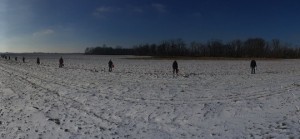SIUE students help conserve archaeological field site

Anthropology students plant seeds at the Gehring Site on the west side of campus in January. (Photo courtesy of Julie Holt)
Often in the field of archaeology, the effects on the ecological environment can be overlooked. In order to create awareness and to help conserve SIUE’s site, anthropology professor Julie Holt and senior Shannon Miller organized a project to not only conserve the local land but the dig site as well.
When Holt led teams of students on archaeological field schools during the summer months, she noticed dense weeds and other invasive species had crept onto the land. Old horseradish plants had grown wild. Ten-foot trees had sprouted on the former farmland.
Holt and Miller led a team of students and contractors to the 35-acre site during the fall semester and removed overgrown and invasive trees and plant species. Holt said the goal was to not only conserve the vegetation and the ecological environment, but also preserve the archaeological site as well. Holt said she encourages students to adhere to the Society for American Archaeology’s Principles of Archaeological Ethics, which calls for researchers to practice accountability and conservation of the archaeological record.
“In all our anthropology classes we are trying to get them to think about ethical concerns,” Holt said. “Especially with senior projects, I spent several sessions talking about archaeological ethics. Ethics is a number one consideration. So we want to practice what we preach and we want to show students this is an example of trying to actually do the ethical thing, conserve the site and help us do it.”
Farming stopped in 2012 to help preserve the archaeological site. But vegetation overgrowth began to overtake the area. SIUE Vice Chancellor for Administration Kenneth Neher helped lead the push for the conservation of the site.
“It took us a couple years to come up with a plan and get the permission to do conservation planting that would conserve the archaeological site and also benefit wildlife, while also at the same time be economically viable,” Holt said.
Miller and a group of students returned to the Gehring site on Jan. 23, where they planted Red-top grass, timothy grass, Black-eyed Susan, Gray-headed coneflower and Patridge Pea. Holt said non-native plants were chosen because native grasses have deeper roots that can infringe upon the site and non-native grasses are more cost efficient. The plants can also provide food for the area wildlife.
Miller, who based her senior project on the conservation, said sources on the subject were limited because few researchers had published work on ecological conservation during field excavation. Miller said it is important for academics to remain wary of ethical concerns during field studies. The senior plans to attend the anthropology department’s field school this summer. Miller hopes to get her research published and create more awareness about conservation in the field.
“It’s educating people. I’m not just reaching out to archaeologists but farmers as well about their farmland. I’m trying to base it on two different groups of people, some who don’t know about sites and some who do and how they can both assist in the ecology of sites.”
Students and contractors use farming equipment to remove the roots of the invasive species and also removed excess weeds during a two day period. Miller monitored the site periodically during the fall and winter months.
Filed Under: Anthropology












